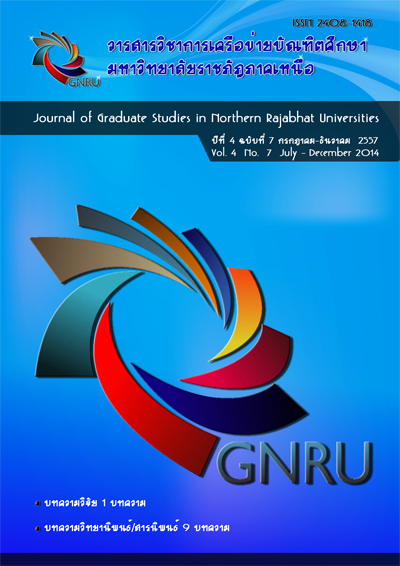แนวทางการพัฒนาธุรกิจการเกษตรในอำเภอชายแดนจังหวัดตาก ; Agribusiness Development in the Border Districts in Tak
Main Article Content
Abstract
บทคัดย่อ
งานวิจัยเรื่องนี้มีวัตถุประสงค์ เพื่อวิเคราะห์สภาพทั่วไปและเสนอแนวทางพัฒนาระบบการบริหารจัดการธุรกิจการเกษตรในพื้นที่ 5 อำเภอชายแดน จังหวัดตาก กลุ่มตัวอย่างเป็นเกษตรกรจำนวน 397 ตัวอย่างการวิจัยครั้งนี้ใช้วิธีวิเคราะห์เชิงปริมาณและวิธีวิเคราะห์เชิงคุณภาพ ผลการวิจัยพบว่า 1. สภาพทั่วไปของธุรกิจการเกษตรส่วนใหญ่แล้ว ปัจจัยในการผลิตจะซื้อจากร้านค้า ที่ดินทำกินเป็นของตนเอง การลงทุนจะลงทุนเองและขอสินเชื่อซึ่งทุนมาจากธนาคาร แรงงานจะใช้ทั้งในครัวเรือนและจ้าง พืชที่ผลิตส่วนใหญ่จะเป็นข้าวโพด การผลิตจะเน้นการขายก่อนการบริโภคไม่มีการแปรรูปผลผลิตและไม่มีความรู้ในการแปรรูปผลผลิต ผลผลิตส่วนใหญ่จะเก็บไว้ในยุ้งฉางของตัวเองผลผลิตเกษตรกรจะนำไปขายในท้องถิ่นเองโดยจ้างรถมาขนส่ง ผลผลิตพลอยได้ของสินค้าเกษตรส่วนใหญ่จะไม่ได้เก็บไว้
2. แนวทางการพัฒนาธุรกิจการเกษตร พบว่า ส่วนใหญ่ให้ความสำคัญกับนโยบายของรัฐในการส่งเสริมจัดหาแหล่งสินเชื่อ การพัฒนาแหล่งน้ำ การผลิตเมล็ดพันธุ์พืช การประกันราคาสินค้าเกษตร การพักชำระหนี้ รวมถึงการพัฒนาการแปรรูปผลผลิตและการจัดจำหน่ายผลิตภัณฑ์
Abstract
The objectives of this study were to analyze general condition of agricultural businesses in Tak, and to figure out what management pattern is best suit agricultural businesses in 5 border districts of Tak province. The study samples were 397 farmers in the 5 border districts in Tak. Data were analyed through the quantitative and the qualitative method.
Study results showed that
1. In terms of general condition of agricultural businesses, most production factors, for instances fertilizers, pesticides, crop seeds and farming tools were not produced but instead purchased from shops while agricultural lands belong to the farmers themselves. Investment funds came from both the farmers’ own pockets and bank loans. Labors were both family members and hired outsiders. The most common grown plant was corn. The priority for most farmers was selling crops, while eating and using them in family was less important. There was no agricultural corps processing and the famers did not know how to do so. Most of agricultural crops were kept in the barn, transported by hired trucks, and sold in the same village where they were planted. Most of agricultural by-products were not stored, and
2. In terms of agricultural business development, most agricultural businesses were well aware and paid attention to government policies on agricultural loans, water development, crops seed production, agricultural product price guarantee, debt moratorium and agricultural product processing and distribution.


